Please Take Note: This is a review of the final game, but it might change slightly based on the success of the Kickstarter campaign. The game is being reviewed on the components and the rules provided with the understanding that “what you see is not what you might get” when the game is published. If you like what you read and want to learn more, we encourage you to visit the game’s web page. Now that we have all that disclaimer junk out of the way, on with the review.

The Basics:
- For ages 10 and up (publishers suggest 14+)
- For 4 to 8 players
- Approximately 60 minutes to complete
Geek Skills:
- Active Listening & Communication
- Counting & Math
- Logical & Critical Decision Making
- Reading
- Strategy & Tactics
- Cooperative & Team Play
- Hand/Resource Management
- Auctioning, Bidding, & Trading
- Worker Placement & Area Control
Learning Curve:
- Child – Easy
- Adult – Easy
Theme & Narrative:
- It’s the zombie apocalypse, ya’ll!
Endorsements:
- Gamer Geek rejected!
- Parent Geek approved!
- Child Geek approved!
Overview
The world has gone to Hell in a handbasket and you are one of the “lucky” survivors. Now you get to spend your time fighting off cannibals, undead, and worse. Yes. Worse. It’s not all bad, though. OK. That’s a lie. It’s all bad. The best you can hope for is surviving just a bit longer than the rest, but even that doesn’t seem like such a great deal. Isn’t the Apocalypse great?
Where’s My Chainsaw, designed by Casey Balsitis, Michael Huensch and to be published by Devious Mind Games, will reportedly be comprised of 85 Special cards, 36 Enemy cards, 65 Item cards, 28 Weapon cards, 12 Hero Point cards, 8 Health cards, 8 Character cards, and 8 Reference cards. As this is a review of a prepublished game, I cannot comment on the game component quality. The illustrations by artist Paul Dozier are a mix of horror and humor, blending the macabre with a smirk that works well within the game’s theme and narrative.
Setting Up for Survival (or a Zombie Meal)
To set up the game, first separate the Special cards, Item cards, Weapon cards, and Enemy cards into separate piles.
Second, separate the Enemy cards into their different pile values (I, II, and III). Shuffle each pile separately and then stack them on top of each other with Enemy pile III on the bottom, Enemy pile II in the middle and Enemy pile I on top. Place this deck of cards face-down in the middle of the playing area. This is the Enemy draw deck for the duration of the game.
Third, repeat the same steps for the Weapon cards as you did for the Enemy cards, separating them into pile values and building the deck accordingly. Place this deck of cards face-down next to the Enemy draw deck. This is the Weapon draw deck for the duration of the game.
Fourth, shuffle and deal each player 1 Character card, 1 Health card, and 1 Hero Point card. Players place their Health card underneath their Character card, ensuring the highest number value is showing. The same is done for the Hero Point card, but use the lowest value.
Shuffle the Special cards into a single deck and the Item cards into a single deck, creating two draw decks. Deal 2 Special cards to each player, face-down. These cards are placed in the player’s hand and should remain hidden until played. Place the Special card draw deck face-down and to one side of the game playing area. Place the Item draw deck face-down next to it.
That’s it for game set up. Determine who will be the first player and begen. Any player who was dealt a Special card that states “Play Immediately” should play it now before the game officially begins.
Cards, Cards, and More Cards
Where’s My Chainsaw? is played entirely with cards (and hands, technically speaking). Each of the major card types is summarized here.
Character Cards
A player’s Character card does two things. First, it gives the player a persona in the game they can optionally act as if they are so inclined. Second, and more importantly, it provides the player with a specific set of special abilities and a victory condition that, if obtained, wins the game.
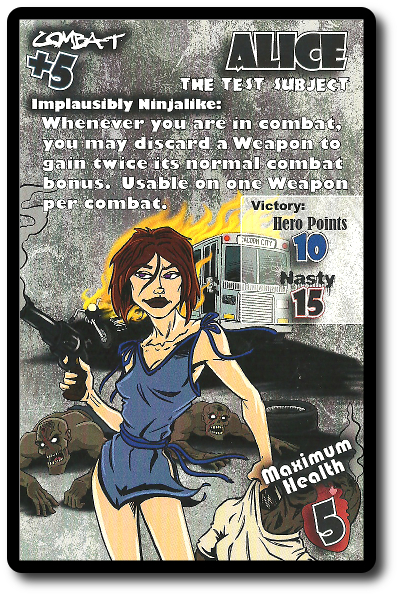
Enemy Cards
The world is overrun by the undead, which pretty much means that the player’s Characters are going to have a hell of time surviving. The Enemy cards cover everything from shambling dead to crazy nutjobs wandering about with knives. Enemy cards display the enemy’s combat value, the number of Items they have on them that can be looted if killed, and nasty stuff that happens when combat doesn’t go so well.
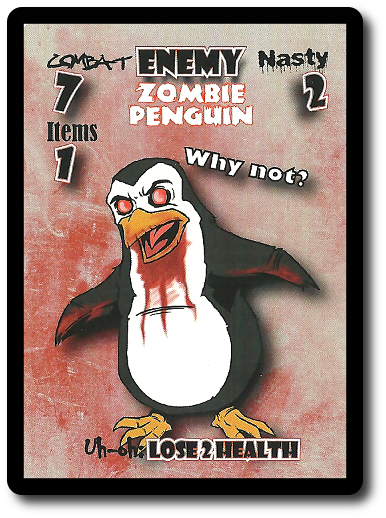
Item Cards
The great thing about living in a world as one of the last remaining humans alive is that you have access to a lot of stuff. Item cards represent all the fun, interesting, and necessary “stuff” a player Character would want or need to ensure they survive for another day. Each Item card comes with its own rules. Some are played and kept while others are played and discarded.
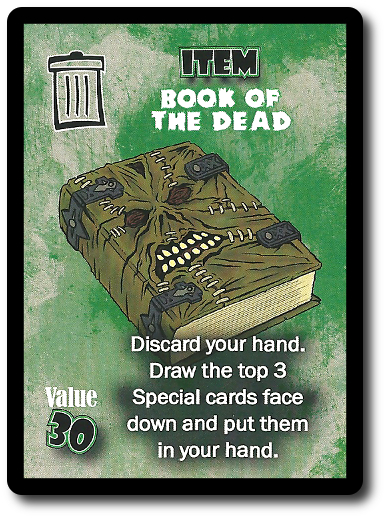
Weapon Cards
It would be unfair to toss the player Character’s into a world that mostly wants to eat them without a weapon or two to defend themselves. In this game, weapons are abundant, and the players will need them! Weapon cards represent the many different real and improvised instruments of pain the player’s Character can acquire, increasing their chances to win battles and survive another day.
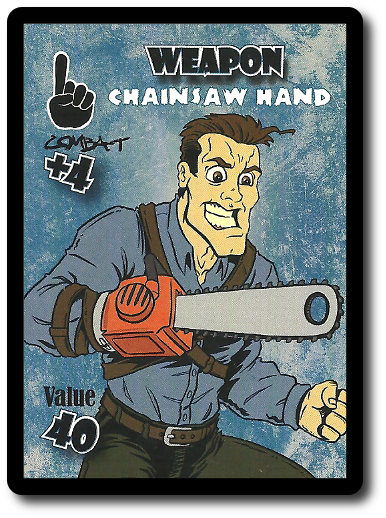
Special Cards
Everything else a player can possibly think about is most likely found in the Special card deck. These cards are collected and played either when the player thinks best or forced upon the game and immediately resolved once draw. Expect oddness, double-crosses, and constant change.
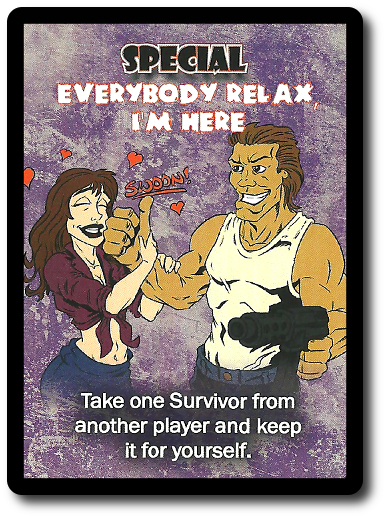
Health Cards
Health cards are used to help keep track of a player’s Character’s Health. It’s placed underneath the Character card and only the Character’s current Health value is shown.
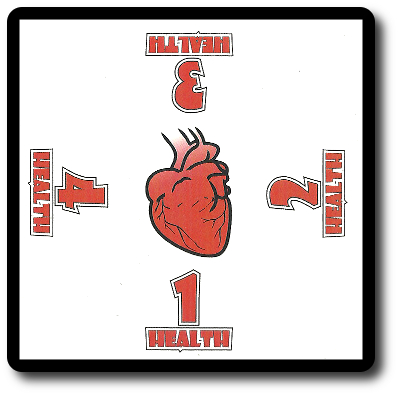
Hero Point Cards
Hero points are a type of currency in the game and can be used to obtain an advantage by acquiring additional cards. Like the Health card, the Health Point card is placed underneath the Character card and only shows the player’s current Hero point value.
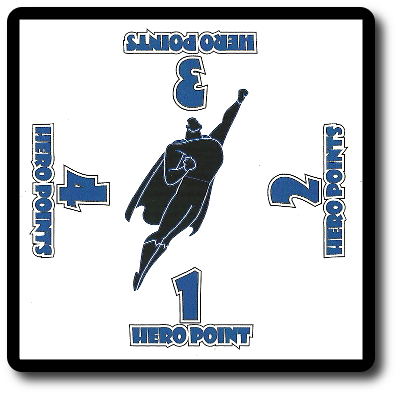
Welcome to the Zombie Apocalypse
Where’s My Chainsaw? is played in rounds and turns. A player’s turn is summarized here.
Step 1: Trade
The very first thing a player can do is initiate a trade with any opponent. The are only two restrictions. Players cannot trade Special cards or Health. Any other card or type goes!
Step 2: Draw or Fight
The active player must now make a choice. They can either draw 2 Special cards (adding them to their hand and playing those that must be played immediately) or draw one Enemy card and engage in combat.
Combat is quickly resolved by comparing the player’s Character’s combat score along with any bonuses provided by other cards that the player wants to use. If the player’s Character’s total combat score is HIGHER than the Enemy card’s combat score, the player wins. A number of cards are then drawn by the victor (listed on the Enemy card) and the defeated Enemy card is taken as a trophy. The player also earns one Hero point for each Enemy that was defeated. If deals were made with an opponent, it must now be resolved before the next step is taken.
If the player’s Character’s total combat score is EQUAL TO or LOWER THAN the Enemy card’s combat score, things get difficult. Additional cards may be discarded by the player to quickly improve their combat score. This includes discarding previously defeated Enemy cards. But be careful. Opponents can play cards to strengthen the Enemy card, making a seemingly easy fight into a near-death experience. If a player cannot beat the Enemy, the suffer the “Uh-Oh” effect, most likely losing Health, discarding the Enemy card and any cards as needed.
Optionally, a player can, if they are feeling overwhelmed, scream for help. The opponent to the player’s immediate left can be asked to assist in combat by providing bonuses. An opponent who assist automatically earns 1 Hero Point for the assist and can request additional cards be given as payment. Once the deal is struck, combat is resumes and the results determined.
Step 3: Spend Points or Go Scavenge
A player may optionally spend 1 Hero point (adjusting their Hero Point card value accordingly) like cash and buy new gear or scavenge for gear. By spending Hero points, the player can draw Item cards (putting them into play right away), search for survivors, search for antidotes and even go looking for more enemies to fight.
A player can go scavenging by discarding any number of Weapon and Item cards, adding up the discarded cards’ values. For every 40 points earned from the discarded cards, the player can draw one card from the Item draw deck. If the player has extra points after drawing cards, they are lost. A player can, if they like, immediately discard the cards they drew to scavenge again.
Step 4: Discard
If the player ends their turn with too many cards in their hand (hand size determined by the number of players in the game), they must discard down until their total hand size is within the game’s limits.
Step 5: Check for Death
All players now check to determine if their Character is still alive. Any player who has a Character with zero Health must now scramble to quickly heal. If the player cannot, their current Character dies and they must draw a new Character to continue playing. The player can no longer win the game, but they can have a great time making sure things go terribly wrong for their surviving opponents. Recently-dead-but-now-miraculously-alive Characters have a tremendous amount of influence in the game and can make or break a player’s attempt at victory.
It’s now the next player’s turn, starting with step 1 noted above.
Victory!
The game can be won two different ways. The first way to win is to be the first player to complete the Character card’s victory condition. As soon as the condition is met, the game ends and the winner is declared. The second way to win is to simply outlast every opponent and have the only living Character left in the game who had not died.
To learn more about Where’s My Chainsaw?, visit the game’s web page.
Final Word
 The Child Geeks had a great time with Where’s My Chainsaw?, finding it to be fast, fun, and easy to enjoy. One Child Geek said, “This game reminds me a lot of Munchkin and I love Munchkin!” The games are very similar, making it all the easier for those players who liked Munchkin to fall madly in love with its horror’esk doppelganger. Another Child Geek said, “I think I like this game better than the other one. I think it plays faster and is just feels more fun.” This was said a few times by other Child Geeks, as well. The game play in Where’s My Chainsaw? feels very streamlined and a player’s turn is quickly completed, leaving the player feeling pretty good about themselves. Best yet, the Child Geeks loved that they were able to come back as “major nasty guys” when their Character’s died. When all the zombies were torn assunder, the Child Geeks voted to approve Where’s My Chainsaw?
The Child Geeks had a great time with Where’s My Chainsaw?, finding it to be fast, fun, and easy to enjoy. One Child Geek said, “This game reminds me a lot of Munchkin and I love Munchkin!” The games are very similar, making it all the easier for those players who liked Munchkin to fall madly in love with its horror’esk doppelganger. Another Child Geek said, “I think I like this game better than the other one. I think it plays faster and is just feels more fun.” This was said a few times by other Child Geeks, as well. The game play in Where’s My Chainsaw? feels very streamlined and a player’s turn is quickly completed, leaving the player feeling pretty good about themselves. Best yet, the Child Geeks loved that they were able to come back as “major nasty guys” when their Character’s died. When all the zombies were torn assunder, the Child Geeks voted to approve Where’s My Chainsaw?
 The Parent Geeks enjoyed the game, especially the casual players who also enjoyed a good deal of geek pop-culture. According to one Parent Geek, “There’s a lot of humor, winks, and smirks in this game. I like how they tied everything in. And the game is pretty good, too!” Another Parent Geek said, “Feels just like Munchkin but plays a bit smoother. It feels a bit less fiddly to me. I like it.” All the Parent Geeks enjoyed the game to various degrees, with the only negative comment being that is was too much like Munchkin or the game’s theme wasn’t completely family friendly. To be fair, there are pictures of some horrific undead, but nothing so over the top that it makes parents grimace. When all the games were over, the Parent Geeks gave Where’s My Chainsaw? their full endorsement, finding the game to be fun and easy to play, with just enough nonsense and player interaction to keep everyone engaged and biting their fingernails in suspense.
The Parent Geeks enjoyed the game, especially the casual players who also enjoyed a good deal of geek pop-culture. According to one Parent Geek, “There’s a lot of humor, winks, and smirks in this game. I like how they tied everything in. And the game is pretty good, too!” Another Parent Geek said, “Feels just like Munchkin but plays a bit smoother. It feels a bit less fiddly to me. I like it.” All the Parent Geeks enjoyed the game to various degrees, with the only negative comment being that is was too much like Munchkin or the game’s theme wasn’t completely family friendly. To be fair, there are pictures of some horrific undead, but nothing so over the top that it makes parents grimace. When all the games were over, the Parent Geeks gave Where’s My Chainsaw? their full endorsement, finding the game to be fun and easy to play, with just enough nonsense and player interaction to keep everyone engaged and biting their fingernails in suspense.
 The Gamer Geeks weren’t having any of it. According to one Gamer Geek, “This is a Munchkin rip off, but I do like the game’s theme.” Another Gamer Geek said, “Feels like a slightly tighter version of Munchkin, but in the end, I didn’t feel that it was different enough or better than the game it’s obviously based off of. Too bad, as I thought it had some good ideas.” To be perfectly clear, none of the Gamer Geeks thought that Where’s My Chainsaw? was poorly designed. They rather liked the trading and personal victory conditions. However, they could never get past the fact that the game itself felt way too similar to a game they had already played many, many times. It’s also worth noting that Gamer Geeks tend to either love or loath Munchkin, which probably influenced their overall level of like or dislike for the game. One Gamer Geek put it perfectly when they said, “If you like Munchkin and horror movies, I’m sure you are going to like this game.” When the last zombie was put down, the Gamer Geeks rejected Where’s My Chainsaw?
The Gamer Geeks weren’t having any of it. According to one Gamer Geek, “This is a Munchkin rip off, but I do like the game’s theme.” Another Gamer Geek said, “Feels like a slightly tighter version of Munchkin, but in the end, I didn’t feel that it was different enough or better than the game it’s obviously based off of. Too bad, as I thought it had some good ideas.” To be perfectly clear, none of the Gamer Geeks thought that Where’s My Chainsaw? was poorly designed. They rather liked the trading and personal victory conditions. However, they could never get past the fact that the game itself felt way too similar to a game they had already played many, many times. It’s also worth noting that Gamer Geeks tend to either love or loath Munchkin, which probably influenced their overall level of like or dislike for the game. One Gamer Geek put it perfectly when they said, “If you like Munchkin and horror movies, I’m sure you are going to like this game.” When the last zombie was put down, the Gamer Geeks rejected Where’s My Chainsaw?
 If you know how to play Munchkin, you can play Where’s My Chainsaw? The game play is very similar, but the overall game feel is different enough to make it worth while. Not all of our players believed that, however. The Gamer Geeks were, in particuar, very put out by how similar the two games were. For those who didn’t care and enjoyed Munchkin, Where’s My Chainsaw? was a goolishly good time. If a player didn’t like Munchkin, they found no love for Where’s My Chainsaw? whatsoever.
If you know how to play Munchkin, you can play Where’s My Chainsaw? The game play is very similar, but the overall game feel is different enough to make it worth while. Not all of our players believed that, however. The Gamer Geeks were, in particuar, very put out by how similar the two games were. For those who didn’t care and enjoyed Munchkin, Where’s My Chainsaw? was a goolishly good time. If a player didn’t like Munchkin, they found no love for Where’s My Chainsaw? whatsoever.
I was a bit disappointed with how little there was to the game that felt new. Having played Munchin way too many times (it’s one of my kids’ favorite after dinner games), I did not once feel that Where’s My Chainsaw? was challenging me to do anything new, although the victory conditions were a welcomed change (albeit a small one). I didn’t feel like I was playing Munchkin, but nor did I feel like I was playing a new game. The similarities between the two are just too noticeable, which is a double-edged sword. On the positive side, the game is easy to learn and easy to play. On the negative side, it doesn’t offer anything new to gamers who are looking for something unique. Of course, if you’ve never played Munchkin, none of this is going to be an issue.
But let’s take a look at this game for what it is, not what it mimics. Are the rules clear? Absolutely. Is the game easy to learn and teach? Without a doubt. Does it provide for entertainment at the gaming table? More times than not. Taking all that into consideration, Where’s My Chainsaw? is not a bad game whatsoever. This is one of those games where you have to play it for yourself to truly understand how you feel about it. As for me, the game made me laugh and smile, which might be the very best you can ask for.
This is a paid for review of the game’s final prototype. Although our time and focus was financially compensated, our words are our own. We’d need at least 10 million dollars before we started saying what other people wanted. Such is the statuesque and legendary integrity of Father Geek which cannot be bought except by those who own their own private islands and small countries.



